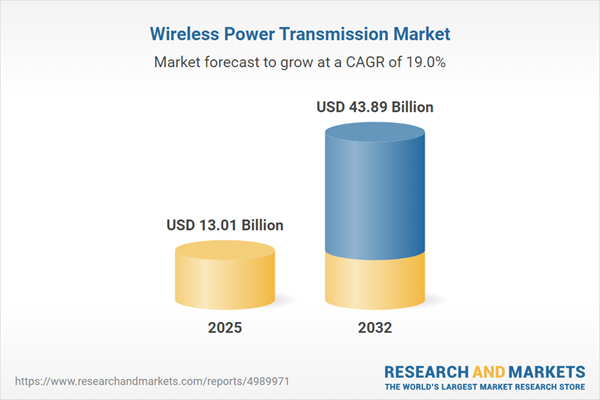Speak directly to the analyst to clarify any post sales queries you may have.
Wireless power transmission is rapidly advancing from experimental concepts to integral solutions across multiple industries, transforming energy delivery models and shaping the next generation of connected systems.
Market Snapshot: Wireless Power Transmission Market Size and Momentum
The Wireless Power Transmission Market grew from USD 10.91 billion in 2024 to USD 13.01 billion in 2025 and is projected to reach USD 43.89 billion by 2032, with a CAGR of 18.99%. This robust acceleration underscores increasing demand for cable-free solutions that maximize convenience, efficiency, and reliability. Segments benefiting include consumer electronics, industrial automation, healthcare devices, and automotive charging, as organizations align with global shifts toward seamless energy transfer and enhanced connectivity.
Scope & Segmentation: Nuanced Insights into Market Landscape
This report thoroughly analyzes the wireless power transmission market, delivering actionable intelligence across a comprehensive set of segments and geographies:
- Application Areas: Automotive (charging stations, electric vehicles), Consumer Electronics (laptops, smartphones, tablets, wearables), Healthcare (diagnostic equipment, implantable devices, therapeutic equipment), Industrial (manufacturing equipment, material handling, robotics), Telecommunications (IoT infrastructure, network devices).
- Technologies: Capacitive coupling, inductive coupling, laser-based, radio frequency, resonant inductive coupling.
- Component Types: Power management modules, receivers, transmitters.
- Operating Frequencies: High frequency, low frequency.
- Regional Analysis: Americas (United States, Canada, Mexico, Brazil, Argentina, Chile, Colombia, Peru); Europe, Middle East & Africa (UK, Germany, France, Russia, Italy, Spain, Netherlands, Sweden, Poland, Switzerland, UAE, Saudi Arabia, Qatar, Turkey, Israel, South Africa, Nigeria, Egypt, Kenya); Asia-Pacific (China, India, Japan, Australia, South Korea, Indonesia, Thailand, Malaysia, Singapore, Taiwan).
- Company Profiles: WiTricity Corporation, Qualcomm Incorporated, Energous Corporation, Powercast Corporation, Texas Instruments Incorporated, NXP Semiconductors N.V., Murata Manufacturing Co., Ltd., Ossia Inc., uBeam Inc., Samsung Electronics Co., Ltd.
Key Takeaways: Strategic Insights for Decision-Makers
- Adoption of wireless power transmission is advancing as manufacturers transition from pilot programs to mainstream deployment in automotive, healthcare, and consumer electronics sectors.
- Recent technological upgrades in resonant inductive coupling and radio frequency solutions are expanding both range and efficiency, enhancing use cases for industrial automation and IoT devices.
- System architects increasingly favor modular, adaptable architectures, enabling effective integration with diverse applications and regulatory environments.
- Strategic focus on interoperability and safety certifications is accelerating market readiness and supporting scalability across different sectors and geographies.
- Collaborations between technology developers, component suppliers, and end users are fostering innovation, enabling solutions tailored to end-market requirements.
Tariff Impact: Navigating Cost and Supply Chain Pressures
U.S. tariff policies introduced in 2025 have materially influenced the wireless power transmission ecosystem. Additional duties on imported components have increased production costs, prompting companies to re-evaluate sourcing, explore onshoring, and optimize design choices to reduce duty burdens. These pressures are reshaping supplier relationships and advancing investment in domestic manufacturing capabilities, with broader implications for total cost of ownership and long-term supply chain resilience.
Methodology & Data Sources
Market insights are derived from a combination of primary interviews with industry experts, regulatory authorities, and end users, as well as secondary research drawing on academic publications, industry white papers, patent filings, and public policy documents. The synthesis of both data streams ensures relevance and technical accuracy.
Why This Report Matters
- Senior leaders receive an executive-ready analysis of global market drivers, segmentation strategies, and competitive landscape nuances in wireless power transmission.
- Insights guide investment prioritization, supply chain resilience strategies, and technology selection amid evolving policy and regulatory complexities.
- Actionable findings equip organizations to evaluate emerging opportunities, anticipate market shifts, and align business objectives with advanced energy solutions.
Conclusion
The wireless power transmission market stands at a pivotal point as innovation, policy decisions, and shifting consumer needs reshape industry norms. Forward-looking organizations that prioritize adaptable strategies and collaborative approaches are poised to realize significant value in this expanding landscape.
Additional Product Information:
- Purchase of this report includes 1 year online access with quarterly updates.
- This report can be updated on request. Please contact our Customer Experience team using the Ask a Question widget on our website.
Table of Contents
3. Executive Summary
4. Market Overview
7. Cumulative Impact of Artificial Intelligence 2025
Companies Mentioned
The companies profiled in this Wireless Power Transmission market report include:- WiTricity Corporation
- Qualcomm Incorporated
- Energous Corporation
- Powercast Corporation
- Texas Instruments Incorporated
- NXP Semiconductors N.V.
- Murata Manufacturing Co., Ltd.
- Ossia Inc.
- uBeam Inc.
- Samsung Electronics Co., Ltd.
Table Information
| Report Attribute | Details |
|---|---|
| No. of Pages | 184 |
| Published | October 2025 |
| Forecast Period | 2025 - 2032 |
| Estimated Market Value ( USD | $ 13.01 Billion |
| Forecasted Market Value ( USD | $ 43.89 Billion |
| Compound Annual Growth Rate | 18.9% |
| Regions Covered | Global |
| No. of Companies Mentioned | 11 |









